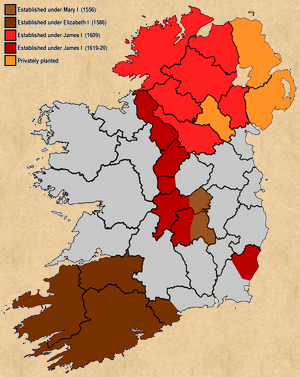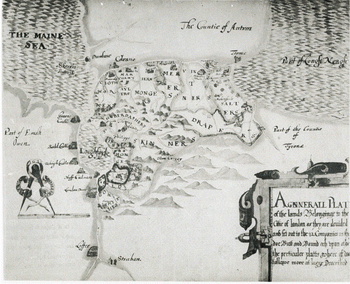Plantation of Ulster




 The Plantation of Ulster was the organised colonisation (or plantation) of Ulster by people from Great Britain. Private plantation by wealthy landowners began in 1606, while official plantation controlled by King James I of England and VI of Scotland began in 1609. All land owned by Irish chieftains the Clan Ó Néill and Clan Ó Domhnaill (O'Donnell Clan) (along with those of their supporters) were confiscated and used to settle the colonists. This land comprised an estimated half a million acres (4,000 km²) in the counties Tyrconnell, Tyrone, Fermanagh, Cavan, Coleraine and Armagh. Most of the counties Antrim and Down were privately colonised. The Plantation of Ulster was the organised colonisation (or plantation) of Ulster by people from Great Britain. Private plantation by wealthy landowners began in 1606, while official plantation controlled by King James I of England and VI of Scotland began in 1609. All land owned by Irish chieftains the Clan Ó Néill and Clan Ó Domhnaill (O'Donnell Clan) (along with those of their supporters) were confiscated and used to settle the colonists. This land comprised an estimated half a million acres (4,000 km²) in the counties Tyrconnell, Tyrone, Fermanagh, Cavan, Coleraine and Armagh. Most of the counties Antrim and Down were privately colonised.
The "British tenants", a term applied to the colonists, were mostly from Scotland and England. They were required to be English-speaking and Protestant. The Scottish colonists were mostly Presbyterian and the English mostly Anglicans. The Plantation of Ulster was the biggest and most successful of the Plantations of Ireland. Ulster was colonised to prevent further rebellion, as it had been the region most resistant to English control during the preceding century.
King James I believed that colonising Ulster would quell rebellion and win over the 'rude and barbarous Irish' to 'civility' and Protestantism.
Prior to its conquest in the Nine Years War of the 1590s, Ulster had been the most Gaelic part of Ireland, a province existing largely outside English control. There were few towns, few roads and much of the country was thickly wooded. Throughout the 16th century Ulster was viewed by the English as being "underpopulated" and undeveloped. An early attempt at plantation of the north of Ireland in the 1570s on the east coast of Ulster by Walter Devereux, 1st Earl of Essex, had failed.
Many of the Gaelic Irish lived by “creaghting” (seasonal migration with their cattle) and as such, permanent habitations were uncommon. The wars fought between Gaelic clans and between the Gaelic and English undoubtedly contributed to depopulation. However by 1600 (before the worst atrocities of the Nine Years War) Ulster's total adult population according to Perceval-Maxwell was only 25,000 to 40,000 people. The 16th century English conquest of Ireland was made piece by piece and starting in the reign of Henry VIII (1542–1547) and only being completed after sustained warfare in the reign of Elizabeth I (1558–1603). During these wars the force of the semi-independent chieftains was broken.
The plan for the plantation was determined by two factors. One was the wish to make sure the settlement could not be destroyed by rebellion as the first Munster Plantation had been in the Nine Years War. This meant that, rather than settling the planters in isolated pockets of land confiscated from Irish rebels, all of the land would be confiscated and then redistributed to create concentrations of British settlers around new towns and garrisons. What was more, the new landowners were explicitly banned from taking Irish tenants and had to import workers from England and Scotland. The remaining Irish landowners were to be granted one quarter of the land in Ulster. The peasant Irish population was intended to be relocated to live near garrisons and Protestant churches. Moreover, the planters were barred from selling their lands to any Irishman and were required to build defences against any possible rebellion or invasion. The settlement was to be completed within three years. In this way, it was hoped that a defensible new community composed entirely of loyal British subjects would be created.
The second major influence on the Plantation was the negotiation among various interest groups on the British side. The principal landowners were to be Undertakers, wealthy men from England and Scotland who undertook to import tenants from their own estates. They were granted around 3000 acres (12 km²) each, on condition that they settle a minimum of 48 adult males (including at least 20 families), who had to be English-speaking and Protestant. However, veterans of the Nine Years War (known as Servitors) led by Arthur Chichester successfully lobbied to be rewarded with land grants of their own.
Since these former officers did not have enough private capital to fund the colonisation, their involvement was subsidised by the twelve great guilds. Livery companies from the City of London were coerced into investing in the project, as were The City of London guilds which were also granted land on the west bank of the River Foyle, to build their own city (Londonderry near the older Derry) as well as lands in County Coleraine. The final major recipient of lands was the Protestant Church of Ireland, which was granted all the churches and lands previously owned by the Roman Catholic Church. The British government intended that clerics from England and the Pale would convert the native population to Protestantism.
 Scottish settlers had been migrating to Ulster for many centuries. Highland Gaelic Scottish mercenaries known as 'Gallowglass' had been doing so since the 15th century and Presbyterian lowland Scots had been arriving since around 1600. From 1609 onwards, British Protestant immigrants arrived in Ulster through direct importation by undertakers to their estates and also by a spread to unpopulated areas, through ports such as Londonderry and Carrickfergus. In addition there was much internal movement of settlers who did not like the original land allotted to them. Most planters settled on uninhabited and unexploited land, often building up their farms and homes on overgrown terrain that has been variously described as “wilderness” and “virgin” ground. Scottish settlers had been migrating to Ulster for many centuries. Highland Gaelic Scottish mercenaries known as 'Gallowglass' had been doing so since the 15th century and Presbyterian lowland Scots had been arriving since around 1600. From 1609 onwards, British Protestant immigrants arrived in Ulster through direct importation by undertakers to their estates and also by a spread to unpopulated areas, through ports such as Londonderry and Carrickfergus. In addition there was much internal movement of settlers who did not like the original land allotted to them. Most planters settled on uninhabited and unexploited land, often building up their farms and homes on overgrown terrain that has been variously described as “wilderness” and “virgin” ground.
By 1622, a survey found there were 6,402 British adult males on Plantation lands, of whom 3,100 were English and 3,700 Scottish – indicating a total adult planter population of around 12,000. However another 4,000 Scottish adult males had settled in unplanted Antrim and Down, giving a total settler population of about 19,000. Despite the fact that the Plantation had decreed that the Irish population be displaced, this did not generally happen in practice. Firstly, some 300 native landowners who had taken the English side in the Nine Years War were rewarded with land grants. Secondly, the majority of the Gaelic Irish remained in their native areas, but often on worse land than before the plantation. They usually lived close to and even in the same townlands as the Protestant settlers. The main reason for this was that Undertakers could not import enough English or Scottish tenants to fill their agricultural workforce and had to fall back on Irish tenants. However in a few heavily populated lowland areas (such as parts of north Armagh) it is likely that some population displacement occurred.
The plantation was a mixed success from the point of view of the settlers. About the time the Plantation of Ulster was planned, the Virginia Plantation at Jamestown in 1607 started. The London guilds planning to fund the Plantation of Ulster switched and backed the London Virginia Company instead. Many British Protestant settlers went to Virginia or New England in America rather than to Ulster.
By the 1630s, there were 20,000 adult male British settlers in Ulster, which meant that the total settler population could have been as high as 80,000. They formed local majorities of the population in the Finn and Foyle valleys (around modern Derry and east Donegal), in north Armagh and in east Tyrone. Moreover, the unofficial settlements in Antrim and Down were thriving. What was more, the settler population grew rapidly, as just under half of the planters were women.
The attempted conversion of the Irish to Protestantism was generally a failure. One problem was language difference. The Protestant clerics imported were usually all English speakers, whereas the native population were usually monoglot Gaelic speakers. However, ministers chosen to serve in the plantation were required to take a course in the Irish language before ordination, and nearly 10% of those who took up their preferments spoke it fluently. Nevertheless, conversion was rare, despite the fact that, after 1621, Gaelic Irish natives could be officially classed as "British" if they converted to Protestantism.
Of those Catholics who did convert to Protestantism, many made their choice for social and political reasons.


|

